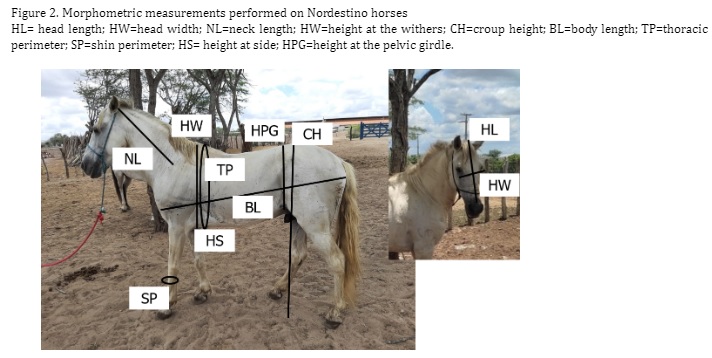Comparison of conventional and imaging methods to obtain morphometric measurements of the Nordestino breed horse
DOI:
https://doi.org/10.21708/avb.2023.17.4.11764Resumo
Characterization studies must be prioritized to allow the maintenance of the racial standard to guarantee the conservation of their genes of origin. The Nordestina breed is a small animal, not exceeding 150 cm for males and 145 cm for females, with a body weight of approximately 280 kg in both sexes. The objective of this research was to compare the conventional method and the imaging method (ImageJ® software) in the performance of morphometric measurements of horses of the Nordestina breed. The morphometric measurements performed were withers height (WH), croup height (CH), body length (BL), neck length (NL), side height (SH), pelvic girdle height (PGH), shin perimeter (SP), chest circumference (CC), face length (FL) and face width (FW). Head length (P=0.045), head width (P=0.001), and shin perimeter (P<.0001) showed a significant difference between the two methods evaluated, these measurements presented higher values when performed by image, but did not present a coefficient of variation greater than 8%. The total canonical correlation between the sets of variables X and Y were 0.99, and the first pair of canonical variables absorbed 85% of the total variation, whose Wilk's and F test (P<0.001) were significant for all canonical pairs, which indicates a strong correlation between the measurements obtained by the conventional method and by imaging. The evaluation of photographs by the ImageJ® software proved to be a viable alternative to the conventional method of taking morphometric measurements in horses of the Nordestina breed.
Downloads

Downloads
Publicado
Edição
Seção
Licença
Copyright (c) 2023 Acta Veterinaria Brasilica

Este trabalho está licenciado sob uma licença Creative Commons Attribution 4.0 International License.
Autores que publicam na Acta Veterinaria Brasilica concordam com os seguintes termos: a) Autores mantém os direitos autorais e concedem à revista o direito de primeira publicação, com o trabalho simultaneamente licenciado sob a Licença Creative Commons Attribution que permite o compartilhamento do trabalho com reconhecimento da autoria e publicação inicial nesta revista. b) Autores têm autorização para assumir contratos adicionais separadamente, para distribuição não-exclusiva da versão do trabalho publicada nesta revista (ex.: publicar em repositório institucional ou como capítulo de livro), com reconhecimento de autoria e publicação inicial nesta revista. c) Autores têm permissão e são estimulados a publicar e distribuir seu trabalho online (ex.: em repositórios institucionais ou na sua página pessoal) a qualquer ponto antes ou durante o processo editorial, já que isso pode gerar alterações produtivas, bem como aumentar o impacto e a citação do trabalho publicado (Veja O Efeito do Acesso Livre).


 Esta obra está licenciada com uma Licença
Esta obra está licenciada com uma Licença 